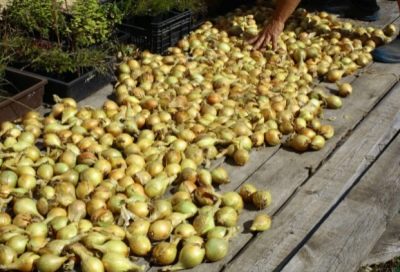
- Authors: Suzan V.G., Karpukhin M.Yu., Alyev T.R., Salomennikova N.F., Alyev R.O.
- Year of approval: 2015
- Ripening terms: mid-season
- Bulb weight, g: 60
- The form: wide elliptical
- Dry scales: dark yellow with brownish tint
- Coloring juicy scales: white
- Density: dense
- Taste: semi-sharp
- Appointment: universal
This variety was approved for use in 2015. It is a type of shallot. This species is particularly resistant to frost, as well as to various diseases, so it is in great demand among gardeners.
Description of the variety
These shallots are a perennial plant with relatively large fruits. The bulbs have excellent storage and transportability. In addition, the culture is characterized by strong branching. A Berezovsky aristocrat can be grown for both turnip and greens. This variety boasts high productivity.
Characteristics of the appearance of plants and bulbs
The branchy aboveground part of the culture has a simple tubular shape and a rich green color. The fruits themselves have a wide elliptical shape. Their sizes are quite large. The average weight of each ripe bulb is 60 grams.
The color of dry scales is dark yellow, with a slight brown tint. The juicy scales are white. The flesh of such an onion is quite dense. The species is considered to be multi-nested. Moreover, each nest contains 5-7 bulbs.
Purpose and taste
Onion Berezovsky aristocrat has a wonderful semi-sharp taste. Its purpose is universal. Ripe vegetables can be eaten raw. They are also perfect for preparing salads, fish and meat dishes. Often the onions are pickled.
Maturation
Berezovsky aristocrat is considered mid-season. On average, it takes 95-100 days to fully ripen.
Yield
This variety of shallots has a high yield. From 1 sq. m of planted area, you can collect an average of 1.6 kg of bulbs.
Growing regions
The Berezovsky aristocrat is particularly frost-resistant, it can withstand temperatures up to -20 degrees, so it is permissible to grow it in many regions. Gardeners plant this variety in the North, North-West, Central, Volgo-Vyatka, Ural, Nizhnevolzhsky, Far East, West and East Siberian regions.
Growing and care
Such shallots are recommended for growing on a turnip in a biennial culture from seedlings. Planting vegetation is best done in high beds. It can be planted before winter from late October or early spring. There should be a distance of at least 7-8 centimeters between individual plants. Such a vegetable should be grown on soil with neutral acidity, the soil should be fairly loose.
Berezovsky aristocrat, like most other varieties, after planting in open ground will need regular watering and feeding. For this onion, fertilizers with potassium, phosphorus and nitrogen will be the best option.

Since the onion is an unpretentious and cold-resistant plant, it can be planted both in spring and autumn. It is necessary to properly prepare the planting material, competently prepare the garden bed and determine the timing of planting.


The bow is not as unpretentious as it seems. For good growth, you need fertile soil, quality care and nutritious fertilizers. Without top dressing, the bulbs will grow small, and the greens will not be lush. At different stages, it should be fed with different substances. The vegetable needs organic and mineral feeding. A good result for fertilizing onions is the use of folk remedies.
Disease and pest resistance
The Berezovsky aristocrat variety is highly resistant to infections and pests. Occasionally, it can be affected by an onion fly. Its larvae form a white coating on the tips of the leaf blades. Over time, they completely affect the entire plant.
Such a culture can also be damaged by the hidden proboscis. He is able to cut an onion feather and lay his larvae there, which in the future will begin to actively feed on the pulp of the bulbs.
The vegetable can be sick with downy mildew. In this case, a light gray bloom will appear on the leaves. When growing a plant in the southern regions, rust infection is possible.
To cure infected vegetation, you can use special fungicides or a solution of copper sulfate. When harmful insects appear on the crop, they are most often treated with solutions with wood ash.

Despite the fact that the onion is a very useful plant, capable of repelling and killing many microbes and bacteria, it itself is often damaged and suffers from various misfortunes. Diseases and pests of onions can significantly reduce the yield. It is necessary to correctly determine the presence of this or that disease and take appropriate measures in time.
Review overview
Most summer residents left positive reviews about the bow Berezovsky aristocrat. Many of them noted that this species has an excellent pleasant taste without bitterness. Bulbs can be used to prepare a wide variety of dishes. In addition, according to gardeners, delicate greens with a pleasant fresh aroma also have a good taste. It was noted that such an onion is absolutely unpretentious in care, planting it is as simple as possible.


















































































